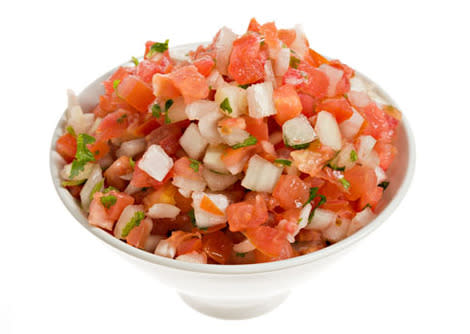Is Homemade Salsa Worth the Effort?

Elizabeth Gunnison, Bon Appetit
In our column Fake It or Make It we test a homemade dish against its prepackaged counterpart to find out what's really worth cooking from scratch.
America loves salsa. A true utility player amongst snack staples, the tomato-based dip is equally at home alongside burgers and hot dogs at a summer barbecue, in front of a football game, or as a simple afternoon snack any day of the week. Store-bought salsa is nearly an $800 million market in the United States, second only to mayonnaise as the nation's favorite condiment. Given that we eat so much of the stuff, I had to wonder whether a from-scratch version would be a noticeable improvement over the jarred versions that I've come to rely upon.
The Contenders
Tostitos All-Natural Chunky Salsa - Medium vs. Bon Appetit's Pico de Gallo
Salsa is simply Spanish for "sauce," but throughout the U.S. the word is commonly used to denote spicy, tomato-based dips that are Mexican or Central American in origin. The making of a sauce by combining chiles, tomatoes and other ingredients has been documented back to the time of the Aztecs, but it was only in the 1970s that the dip really took off stateside. Today we have several different varieties of salsa, ranging from cooked tomato salsa roja to fresh pico de gallo to tomatillo-based salsa verde. Most jarred salsas sold in the United States are forms of pico de gallo (also known as salsa cruda), which take advantage of tomatoes' high acidity levels and heat processing to create a very shelf-stable product. While some salsa purists criticize these products as not real salsa cruda (the tomatoes in these versions are, after all, cooked), we have their widespread availability and long shelf life to thank for salsa's enormous popularity across the U.S.
Relative Costs
About the same. I paid $3.49 for a 15-ounce jar of Tostitos, which worked out to $2.10 per cup. Ingredients to make 2 cups of my own cost $6, or $2.40 per cup.
Relative Healthfulness
Edge to homemade. Both dips are loaded with vegetables, but the store-bought version is much higher in sodium than homemade.
Time Commitment
It took me 45 minutes to make salsa from scratch.
Leftovers Potential
Homemade should be consumed the same day that it's made, or it will become soggy. Store-bought is typically good unopened for more than a year from the date of purchase, and at least 3 weeks once opened.
What The Testers Said
First let me introduce our panel.
THE HEALTH NUT
A delicate eater, the health nut is calorie conscious but also likes to eat well
THE FOODIE
Calorie agnostic, our foodie judge has a sophisticated palate and a love of cooking
THE DUDE
Ambivalent toward food trends and health concerns, this guy just wants to be fed when he's hungry
THE KID
Between ages of 9 and 12 years old, not jaded, typically not into strong flavors
Testers sampled both salsas blind, alone and with tortilla chips.
The Health Nut: Homemade; "The homemade looks and tastes fresher and healthier. I wouldn't serve store-bought to guests."
The Foodie: Store-bought; "I prefer the texture of the homemade, but I think the store-bought has better flavor."
The Kid: Store-bought; "I like how it's smoother and less vegetables."
The Dude: Store-bought. "The homemade definitely looks nicer, but I like the taste of the store-bought better, and I think it tastes better on chips."
The Verdict: Fake it.
Especially when tomatoes are out of season during the winter months, a fresh homemade salsa isn't always worth the time--especially when you're feeding a crowd.
More fromBon Appetit:
10 Foods You Thought Were Healthy But Really Aren't
The Top Food Trends of 2012
25 One-Bite Appetizers
Quick and Easy School-Night Dinners
